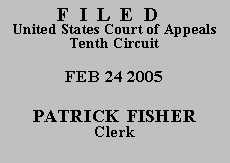

| BARTLETT ELLIOTT,
Plaintiff-Appellant, Defendant-Appellee. |
No. 04-2330
(D.C. No. CIV-04-240 MCA/WDS) |
The legal sufficiency of a complaint is a question of law; we therefore review de novo a Rule 12(b)(6) dismissal. Sutton v. Utah State Sch. For Deaf & Blind, 173 F.3d 1226, 1236 (10th Cir. 1999). "A court reviewing the sufficiency of a complaint presumes all of plaintiff's factual allegations are true and construes them in the light most favorable to the plaintiff." Hall v. Bellmon, 935 F.2d 1106, 1109 (10th Cir. 1991).
42 U.S.C. § 1983 provides a remedy for constitutional violations committed by state actors. Under § 1983, liability attaches only to conduct occurring "under color of law." Thus, the only proper defendants in a § 1983 claim are those who "'represent [the state] in some capacity, whether they act in accordance with their authority or misuse it.'" Nat'l Collegiate Athletic Ass'n v. Tarkanian, 488 U.S. 179, 191 (1988) (quoting Monroe v. Pape, 365 U.S. 167, 172 (1961)).
The Supreme Court has applied a variety of tests to determine whether conduct constitutes state action. In some instances, the Court considers "whether there is a sufficiently close nexus between the State and the challenged action of the regulated entity so that the action of the latter may be fairly treated as that of the State itself." Jackson v. Metro. Edison Co., 419 U.S. 345, 351 (1974). The Court has also inquired whether the state has "so far insinuated itself into a position of interdependence" with the private party, Burton v. Wilmington Parking Auth., 365 U.S. 715, 725 (1961), that there is a "symbiotic relationship" between them. Moose Lodge No. 107 v. Irvis, 407 U.S. 163, 175 (1972). In addition, the Court has held that if a private party is "a willful participant in joint activity with the State or its agents," then state action is present. Adickes v. S.H. Kress & Co., 398 U.S. 144, 152 (1970) (quotation omitted). Finally, the Court has ruled that a private entity that exercises "powers traditionally exclusively reserved to the State" is engaged in state action. Jackson, 419 U.S. at 352.
Applying any of these four tests, Mr. Elliott fails to demonstrate sufficient evidence of state action to state a claim upon which relief may be granted. In response to the district court's order to show cause, Mr. Elliott alleged Chrysler Corporation should be considered a state actor because, inter alia, Chrysler pays taxes and was "bailed out" by the federal government. Mr. Elliott's allegations, even if true, simply fail to establish that Chrysler is a state actor subject to a federal civil rights claim under §1983.
Although we construe Mr. Elliott's pro se pleadings liberally and apply a less stringent standard than we would to pleadings filed by lawyers, Haines v. Kerner, 404 U.S. 519, 520-21 (1972), we "will not supply additional factual allegations to round out [his] complaint or construct a legal theory on [his] behalf." Whitney v. New Mexico, 113 F.3d 1170, 1173-74 (10th Cir. 1997) (citation omitted). We thus AFFIRM the district court's dismissal of Mr. Elliott's claim.
SUBMITTED FOR THE COURT
Stephanie K. Seymour
Circuit Judge
*.After examining appellant's brief and the appellate record, this panel has determined unanimously that oral argument would not materially assist the determination of this appeal. See Fed. R. App. P. 34(a)(2) and 10th Cir. R. 34.1(G). The case is therefore submitted without oral argument. This order and judgment is not binding precedent, except under the doctrines of law of the case, res judicata, or collateral estoppel. The court generally disfavors the citation of orders and judgments; nevertheless, an order and judgment may be cited under the terms and conditions of 10th Cir. R. 36.3.